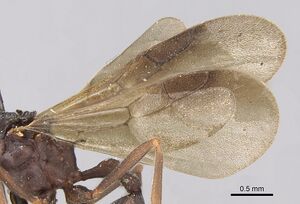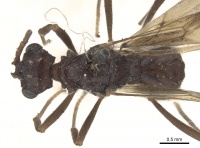Myrmicocrypta dilacerata
| Myrmicocrypta dilacerata | |
|---|---|

| |
| Scientific classification | |
| Kingdom: | Animalia |
| Phylum: | Arthropoda |
| Class: | Insecta |
| Order: | Hymenoptera |
| Family: | Formicidae |
| Subfamily: | Myrmicinae |
| Tribe: | Attini |
| Genus: | Myrmicocrypta |
| Species: | M. dilacerata |
| Binomial name | |
| Myrmicocrypta dilacerata (Forel, 1885) | |
| Subspecies | |
| |
Identification
Distribution
Latitudinal Distribution Pattern
Latitudinal Range: 19.204° to 17.972222°.
| North Temperate |
North Subtropical |
Tropical | South Subtropical |
South Temperate |
- Source: AntMaps
Distribution based on Regional Taxon Lists
Neotropical Region: Belize, Costa Rica, Honduras, Mexico (type locality), Nicaragua, Panama.
Distribution based on AntMaps
Error creating thumbnail: Unable to save thumbnail to destination
Distribution based on AntWeb specimens
Check data from AntWeb
Countries Occupied
| Number of countries occupied by this species based on AntWiki Regional Taxon Lists. In general, fewer countries occupied indicates a narrower range, while more countries indicates a more widespread species. |

|
Estimated Abundance
| Relative abundance based on number of AntMaps records per species (this species within the purple bar). Fewer records (to the left) indicates a less abundant/encountered species while more records (to the right) indicates more abundant/encountered species. |

|
Biology
|
Flight Period
| X | X | X | X | X | X | X | |||||
| Jan | Feb | Mar | Apr | May | Jun | Jul | Aug | Sep | Oct | Nov | Dec |
Source: Kaspari et al., 2001.
- Check details at Worldwide Ant Nuptial Flights Data, AntNupTracker and AntKeeping.
 Explore: Show all Flight Month data or Search these data. See also a list of all data tables or learn how data is managed.
Explore: Show all Flight Month data or Search these data. See also a list of all data tables or learn how data is managed.
Castes
Images from AntWeb

| |
| Male (alate). Specimen code casent0281771. Photographer Shannon Hartman, uploaded by California Academy of Sciences. | Owned by NHMUK, London, UK. |
Nomenclature
The following information is derived from Barry Bolton's Online Catalogue of the Ants of the World.
- dilacerata. Glyptomyrmex dilaceratum Forel, 1885a: 365 (m.) MEXICO. Combination in Myrmicocrypta: Forel, 1899c: 38. Current subspecies: nominal plus cornuta.
Description
References
- Forel, A. 1885a [1884]. Études myrmécologiques en 1884 avec une description des organes sensoriels des antennes. Bull. Soc. Vaudoise Sci. Nat. 20: 316-380 (page 365, male described)
- Forel, A. 1899d. Formicidae. [part]. Biol. Cent.-Am. Hym. 3: 25-56 (page 38, Combination in Myrmicocrypta)
- Kaspari, M., Pickering, J., Longino, J., Windsor, D. 2001. The phenology of a Neotropical ant assemblage: evidence for continuous and overlapping reproduction. Behavioral Ecology and Sociobiology 50, 382–390 (doi:10.1007/s002650100378).
References based on Global Ant Biodiversity Informatics
- Dattilo W. et al. 2019. MEXICO ANTS: incidence and abundance along the Nearctic-Neotropical interface. Ecology https://doi.org/10.1002/ecy.2944
- Del Toro, I., M. Vázquez, W.P. Mackay, P. Rojas and R. Zapata-Mata. Hormigas (Hymenoptera: Formicidae) de Tabasco: explorando la diversidad de la mirmecofauna en las selvas tropicales de baja altitud. Dugesiana 16(1):1-14.
- Fernandes, P.R. XXXX. Los hormigas del suelo en Mexico: Diversidad, distribucion e importancia (Hymenoptera: Formicidae).
- Fernández, F. and S. Sendoya. 2004. Lista de las hormigas neotropicales. Biota Colombiana Volume 5, Number 1.
- Kempf, W.W. 1972. Catalago abreviado das formigas da regiao Neotropical (Hym. Formicidae) Studia Entomologica 15(1-4).
- Rojas Fernandez P. 2010. Capítulo 24. Hormigas (Insecta: Hymenoptera: Formicidae). In: Diversidad Biológica de Veracruz. Volumen Invertebrados. CONABIO-Gobierno del Estado de Veracruz.
- Vasquez-Bolanos M. 2011. Checklist of the ants (Hymenoptera: Formicidae) from Mexico. Dugesiana 18(1): 95-133.
- Vásquez-Bolaños M. 2011. Lista de especies de hormigas (Hymenoptera: Formicidae) para México. Dugesiana 18: 95-133
- Wheeler W. M. 1907. A collection of ants from British Honduras. Bulletin of the American Museum of Natural History 23: 271-277.

